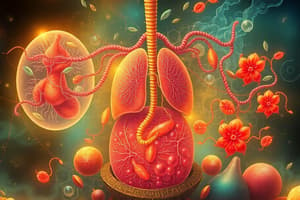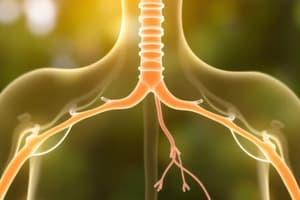Podcast
Questions and Answers
What primary purpose does respiration serve in the body?
What primary purpose does respiration serve in the body?
- To remove carbon dioxide
- To enhance oxygen intake
- To increase breathing rate
- To metabolize nutrients and produce ATP (correct)
Which type of respiration occurs without oxygen?
Which type of respiration occurs without oxygen?
- Oxidative phosphorylation
- Aerobic respiration
- Cellular respiration
- Anaerobic respiration (correct)
Which cells conduct cellular respiration with a nuclear envelope?
Which cells conduct cellular respiration with a nuclear envelope?
- Prokaryotic cells
- Bacterial cells
- Eukaryotic cells (correct)
- Red blood cells
What is the main byproduct of glucose metabolism during cellular respiration?
What is the main byproduct of glucose metabolism during cellular respiration?
At what respiratory rate range does an adult typically breathe?
At what respiratory rate range does an adult typically breathe?
What are the two common modes of anaerobic respiration?
What are the two common modes of anaerobic respiration?
What is produced at the end of glycolysis from glucose?
What is produced at the end of glycolysis from glucose?
Which enzyme is responsible for converting glyceraldehyde-3-phosphate (G3P) into NADH during glycolysis?
Which enzyme is responsible for converting glyceraldehyde-3-phosphate (G3P) into NADH during glycolysis?
What occurs primarily during the Krebs cycle?
What occurs primarily during the Krebs cycle?
What is one key difference between aerobic and anaerobic respiration?
What is one key difference between aerobic and anaerobic respiration?
Which of the following correctly describes the final step of oxidative phosphorylation?
Which of the following correctly describes the final step of oxidative phosphorylation?
What results from the conversion of one molecule of glucose during glycolysis?
What results from the conversion of one molecule of glucose during glycolysis?
What is the primary energy carrier produced during glycolysis?
What is the primary energy carrier produced during glycolysis?
In lactic acid fermentation, what is the final product from pyruvate?
In lactic acid fermentation, what is the final product from pyruvate?
Which step of cellular respiration occurs in the mitochondria?
Which step of cellular respiration occurs in the mitochondria?
Flashcards
Respiration (Biochemistry)
Respiration (Biochemistry)
The process of breaking down nutrients, like glucose, to produce energy (ATP), and releasing waste products like carbon dioxide and water.
Aerobic Cellular Respiration
Aerobic Cellular Respiration
A type of respiration that occurs in the presence of oxygen. It's the most common type of respiration in humans, with every cell participating.
Anaerobic Respiration
Anaerobic Respiration
A type of respiration that occurs without oxygen. This happens when the body needs energy faster than aerobic respiration can supply it, like during intense exercise.
Mitochondria
Mitochondria
Signup and view all the flashcards
ATP (Adenosine Triphosphate)
ATP (Adenosine Triphosphate)
Signup and view all the flashcards
Glycolysis
Glycolysis
Signup and view all the flashcards
Lactic Acid Fermentation
Lactic Acid Fermentation
Signup and view all the flashcards
Alcoholic Fermentation
Alcoholic Fermentation
Signup and view all the flashcards
Pyruvate Oxidation
Pyruvate Oxidation
Signup and view all the flashcards
Krebs Cycle (Citric Acid Cycle)
Krebs Cycle (Citric Acid Cycle)
Signup and view all the flashcards
Oxidative Phosphorylation
Oxidative Phosphorylation
Signup and view all the flashcards
Glucose
Glucose
Signup and view all the flashcards
Pyruvate
Pyruvate
Signup and view all the flashcards
Study Notes
Respiration: Definition and Process
- Respiration is the metabolic process of converting nutrients into usable energy (ATP) and releasing waste products.
- Common usage equates respiration with breathing.
- Aerobic respiration: Occurs in the presence of oxygen; crucial for efficient energy production.
- Anaerobic respiration: Occurs without oxygen, less efficient than aerobic respiration.
- Lactic acid fermentation and alcoholic fermentation are two common anaerobic respiration methods.
Breathing Rate and Health
- Breathing rate (breaths per minute) is an indicator of health.
- Rates vary by age.
- Breathing is the initial step in cellular respiration, not the entire process.
- Example rates by age are listed in the text
Cellular Respiration Process
- All organisms require respiration, regardless of structure or environment.
- Eukaryotic and prokaryotic cells both need cellular respiration to produce energy.
- Respiration involves breaking down glucose with oxygen to yield energy, water, and carbon dioxide.
- Prokaryotes complete the process in their cytoplasm and cellular membrane.
- Eukaryotes start in the cytoplasm and finish in the mitochondrion.
Aerobic Cellular Respiration Equation
- The equation simplifies a complex process: Glucose+Oxygen -> Carbon dioxide + Water + ATP (Energy)
Types of Respiration
- Aerobic respiration uses oxygen.
- Anaerobic respiration (fermentation) uses other pathways to produce energy.
- Lactic acid fermentation produces lactic acid.
- Alcoholic fermentation produces ethanol and carbon dioxide.
Glycolysis
- Glycolysis occurs in the cytoplasm.
- Breaks down glucose (a 6-carbon sugar) into two pyruvate molecules (3-carbon).
- Produces two ATP molecules.
Citric Acid Cycle (Krebs Cycle)
- Occurs in the mitochondrion in eukaryotes and cytoplasm in prokaryotes.
- A cyclical process not directly ATP-producing but producing electron carriers NADH and FADH2 essential for the next stage.
- Acetyl CoA is a crucial intermediate in the cycle.
- Key byproducts are carbon dioxide and water.
Oxidative Phosphorylation (Electron Transport Chain and Chemiosmosis)
- Takes place in the mitochondrial inner membrane.
- Electron transport chain harnesses the energy released by electrons to create a proton gradient.
- Chemiosmosis utilizes this gradient to synthesize ATP from ADP (adenosine diphosphate).
- This is where most ATP from aerobic respiration is produced.
- Electron carriers (NADH & FADH2) from previous stages contribute to the energy generation.
- Oxygen is the final electron acceptor in the chain resulting in the formation of water.
By-Products and Purpose of Respiration
- Water and carbon dioxide are byproducts.
- Respiration releases energy from nutrients, useful for bodily functions.
- Water helps with homeostasis.
- Plants use carbon dioxide in photosynthesis.
Other Respiration Types
- Methanogenesis: A type of anaerobic respiration produces methane.
- Methanogenesis is carried out by archaea bacteria in various environments.
Studying That Suits You
Use AI to generate personalized quizzes and flashcards to suit your learning preferences.




